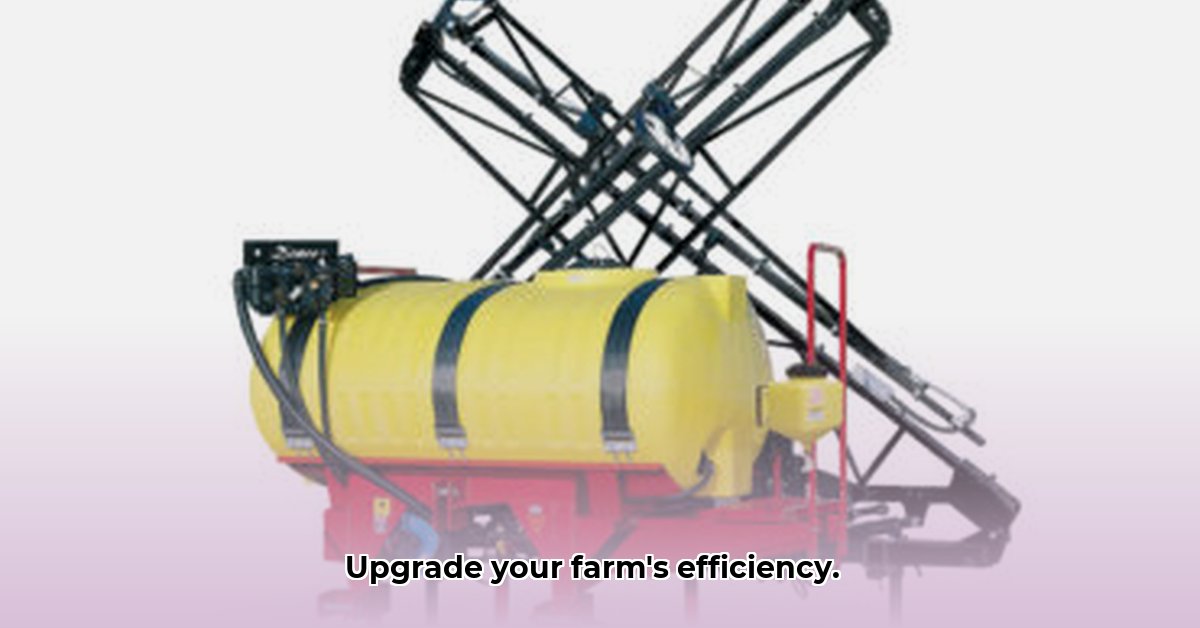
Choosing the right 3-point tractor sprayer is crucial for efficient and sustainable farming. This guide helps you select a sprayer that optimizes application, minimizes environmental impact, and ensures regulatory compliance. We'll cover capacity, boom width, pump types, precision technologies, and maintenance, empowering you to make an informed decision. For more in-depth information, check out this helpful resource on 3-point sprayers.
Sprayer Capacity and Selection: Sizing Up Your Needs
Determining the appropriate tank capacity is the first step. Factors to consider include field size, crop type, and application frequency. A smaller farm might only require a 60-gallon (227-liter) tank, while larger operations could need significantly more, possibly up to 1950 gallons (7394 liters) or even more. Insufficient capacity leads to increased refill trips and lost productivity; overcapacity results in unnecessary expense. Don't forget to match the sprayer's weight to your tractor's lifting capacity. A 20-acre farm might be perfectly served by a 100-gallon sprayer, while a 1000-acre farm likely needs a much larger capacity. How much capacity do you need for optimal efficiency?
Boom Width and Nozzle Selection: Precise Application for Optimal Results
Boom width significantly impacts application speed and efficiency. Wider booms cover more ground per pass, but maneuverability decreases, especially in smaller fields or around obstacles. The choice depends on your field size and layout. Coupled with boom width is nozzle selection. Various nozzles create different spray patterns and droplet sizes, influencing application rate and drift. Selecting the appropriate nozzle ensures even coverage, minimizing waste and environmental impact. The "finer" the spray, the less drift, but the slower the coverage. A larger, coarser spray goes faster but risks more drift. What nozzle type best balances your needs for coverage and minimal chemical drift?
Pump Types and Their Suitability: Powering Your Spray Operation
The pump is the heart of the sprayer. Several types exist, each with advantages and disadvantages. Centrifugal pumps are cost-effective for high-volume applications but may struggle with thicker liquids. Diaphragm pumps offer reliability and are suitable for various liquids, but they might require more frequent maintenance. Roller pumps provide consistent pressure but can be less efficient at higher pressures. The ideal pump depends on the viscosity of your chemicals and your application requirements. High-pressure systems are needed for certain formulations and crops; choosing the wrong pump could result in uneven coverage or pump failure. What aspects of your operation most influence pump type selection?
Precision Spraying Technologies: Enhancing Efficiency and Sustainability
Precision agriculture technologies significantly improve spraying efficiency and reduce environmental impact. GPS guidance ensures straight passes, preventing overlaps and gaps, while variable-rate application (VRA) allows applying differing chemical amounts to varied field areas based on need. This technique minimizes chemical use, saving costs and protecting the environment. These technologies represent a significant investment but can provide a substantial return on investment over time through significant chemical savings. How can integrating precision technologies improve your farming operation's sustainability and profitability?
Environmental Considerations: Minimizing Your Footprint
Sustainable agriculture necessitates minimizing the environmental impact of spraying. Chemical drift, water usage, and the overall carbon footprint should be considered. Employing appropriate nozzles and spraying techniques minimizes drift, while efficient pumps reduce water use. Responsible chemical selection and application are crucial aspects of sustainable farming practices. In many regions, stricter regulations around chemical drift are being implemented. How can you minimize the environmental impact of your spraying operations?
Maintenance and Longevity: Extending the Life of Your Sprayer
Regular maintenance is crucial for optimal sprayer performance and longevity. Thorough cleaning after each use prevents clogging and corrosion. Regular inspection of hoses, nozzles, and other components helps identify wear or damage early. Proper lubrication and timely repairs ensure continued trouble-free operation, avoiding costly downtime and replacements. It is important to consider your area's climate; rust can be a significant issue in humid climates. How frequently should you perform routine maintenance checks on your 3-point sprayer?
Regulatory Compliance: Adhering to Local Regulations
Understanding and complying with local and national regulations concerning pesticide use and handling is vital. This includes licensing, storage, and application guidelines. Non-compliance can result in fines and legal repercussions. Regulations vary widely by region, and staying informed about applicable regulations is crucial. Are you familiar with the pesticide regulations in your area?
Choosing Your Sprayer: A Step-by-Step Guide
- Assess your needs: Field size, crop type, application frequency.
- Determine tank size: Match your operations’ requirements.
- Select boom width: Consider field size and maneuverability.
- Choose the right pump: Consider the chemicals you use and their requirements.
- Explore precision technologies: GPS and VRA features.
- Compare models: Features, durability, cost.
- Prioritize durability: Corrosion-resistant materials.
- Verify regulatory compliance: Check local and national regulations.
By carefully considering these factors, you can choose a 3-point tractor sprayer that optimizes your farming operation’s efficiency, sustainability, and complies with all applicable regulations. Investing time in thorough research and selection will pay off in the long run with increased productivity and reduced environmental impact.